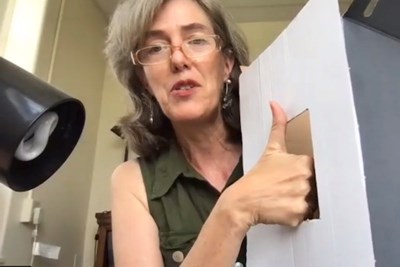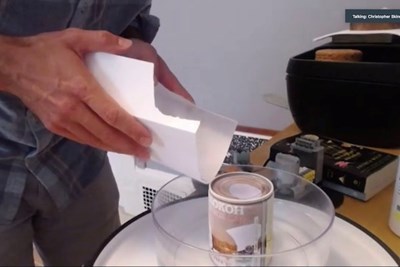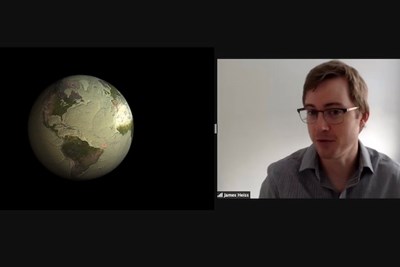Climate change lessons reach beyond the science classroom
UML faculty share multidisciplinary approaches with K-12 educators

Chris Skinner, assistant professor of environmental, earth and atmospheric sciences (EEAS), carefully places a frozen can of coconut milk into the center of a clear plastic bowl filled with room-temperature water. He then turns on a toy motor made of Legos, which begins spinning the Lazy Susan on which the bowl sits in a counterclockwise motion.
With a Zoom screen full of K-12 science teachers looking on, Skinner then adds to the bowl four drops of potassium permanganate, a common chemical compound that quickly creates a bright magenta pinwheel pattern in the water. Next, he sprinkles in a few small, blue paper dots, which gravitate toward the frozen can.
Skinner was showing the teachers, via webcam, how to create an inexpensive, do-it-yourself “Hadley Cell” in their classrooms to help students visualize Earth’s atmospheric circulation patterns.
The demonstration was part of “Integrating Climate Change into the K-12 Classroom,” a free, two-day professional development workshop hosted by EEAS Assoc. Teaching Prof. Lori Weeden and the university’s Climate Change Initiative.
The workshop, which Weeden started in 2018 with a $6,000 grant from the university’s Sustainability Encouragement & Enrichment Development (S.E.E.D.) Fund, introduces ways to teach students about climate change beyond just the science classroom.

Ten UML faculty members representing the Kennedy College of Sciences, the Francis College of Engineering and the College of Fine Arts, Humanities and Social Sciences volunteered as guest lecturers.
Assoc. Prof. of Art History and Architecture Marie Frank shared how students can observe ways that building and landscape designs are responding to climate change, such as larger gutters for increased stormwater runoff. EEAS Asst. Prof. James Heiss talked about how rising sea levels are a threat to groundwater drinking supplies. Political Science Asst. Teaching Prof. Vanessa Gray addressed how to teach climate change during politically polarized times.
“It’s not just about science and engineering,” Weeden says. “We need arts, policy, sociology, history, communication and economics. We need to demonstrate how not acting on climate change is much worse for the economy than doing something about it.”
Kara O’Brien, an eighth grade biology teacher in Greenfield, Massachusetts, says Assoc. Prof. of Plastics Engineering Meg Sobkowicz’s talk on sustainable energy and materials sparked ideas for creative, hands-on problem solving. And she also plans to incorporate the En-ROADS climate change solutions simulator presented by EEAS Prof. Juliette Rooney-Varga into her curriculum.

“Students have a wide variety of talents and interests, so it was helpful to see how art, history, architecture and sociology could be used to increase student engagement in climate change curriculum,” says O’Brien, a first-time workshop participant.
Deanna Hoffman, another first-time participant, is starting a new job this fall as middle school science instructional coach for the Chelsea Public Schools. She enjoyed hearing History Prof. Chad Montrie discuss the roots of climate change activism — particularly his research on Cesar Chavez and the United Farm Workers' impact on the environment.
“I will be working in a district with a student population that is 86% Hispanic, and I am excited about working with teachers to develop this sort of culturally responsive curriculum. I hadn't made that connection before attending Dr. Montrie's session,” says Hoffman, who hopes to incorporate some of Montrie’s primary sources in English and Spanish into her curriculum.
The workshop, which also featured Assoc. Prof. of Art History Kristen Swenson and Assoc. Prof. of Sociology Charlotte Ryan, concluded with a presentation by Clinical Assoc. Prof. of Education Eliza Bobek — a former K-12 science teacher who shared resources from NASA and the National Oceanic and Atmospheric Administration that teachers could integrate into their lesson plans.
Weeden, who plans to share video recordings of the sessions on the CCI website so teachers from anywhere can access the content, will be taking a step back from the workshop next year as she begins pursuing her Leadership in Education Ph.D. in the School of Education.
“There’s not as much need for me to do this, which is wonderful news,” she says. “Climate change awareness has really skyrocketed over the last four years, which is exactly what we wanted.”